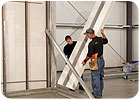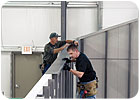
Tom Sturges hadn’t even thought of doing anything unconventional a year ago when he was preparing to break ground on a new headquarters for his family’s 107-year-old business, Pennsylvania Drilling.
“We had plans already drawn up for a traditional, conventional building, but when my builder said he was looking at a new way that could really cut my energy costs, we thought we’d take a look,” Sturges, president of the firm, said. The process led him to being the first owner of a building made of accel-E “Steel Thermal Efficient Panels” (STEPs) created by a new company, Accelerated Building Technologies.
The new company is a joint venture of Dietrich Metal Framing and Nova Chemicals, a global leader in the manufacture of expandable polystyrene (EPS). Four years ago the two companies were both independently trying to figure out ways to grow their businesses, and–the way they tell it– nearly bumped into each other as they each explored the world for a partner to develop better wall systems which would be faster, cheaper, and more energy efficient. The result has been a most serendipitous arrangement: The new panels were unveiled earlier this year at about the same time crude oil was hitting all-time highs. For more about the company, see related article on page 43.

CUTTING COSTS AND BUILDING TIME
Sturges was intrigued as his builder, Tony Rosenberger, owner of Exterior Systems Industries in Pittsburgh, explained the advantages of scrapping the plans and going with the new and then-untested accel-E system. Rosenberger explained that the new building would be at the cutting edge of the “green” movement and would cut energy costs by more than half. Indeed, the new building would look exactly like what was originally intended.“We looked into it and we liked the idea of the whole environmentally-sound, strong insulation way to go,” Sturges explained, noting that he and his son, Caleb, who is the fourth generation in the firm, did quite a bit of research into what Rosenberger proposed. Their research included visiting building sites where traditional buildings were being constructed. “The more we studied it the more we liked it.”
Sturges was also not put off much by the estimated initial cost of the 4,500-square foot building, which was to have accel-E panels covered by brick. He gently questions Rosenberger’s estimate that the energy savings will pay off the additional building’s costs in about five years, but is confident it’s going to be pretty darn quick nevertheless: “Our company is 107 years old,” Sturges said. “So we tend to take a long view of these sorts of things.”
While Rosenberger describes his firm as “very small,” he’s had plenty of experience with steel structural buildings and enjoyed being a consultant on tweaking the final design of Accelerated’s new panels, as well as being the first contractor to use it in the field.
“We were the first one out of the hole when they designed the system,” Rosenberger said. “We had a chance to experiment with the product. We were able to touch it, feel it and smell it.”
He said he found it rather easy to persuade Sturges to convert his plans, as he stressed the energy savings since the 8-inch walls would be virtually airtight, have a high R-value (especially after adding additional fiberglass insulation) and the ceilings would have an R-value of 45. Sturges’s building also has a geothermal heating system. Rosenberger also stressed the ease of construction and huge savings in labor costs.
Rosenberger and Accelerated’s management say the system is more akin to working with an Erector set than traditional building. Because the panels are manufactured of very lightweight EPS foam and have only two steel studs 24 inches on center, they weigh very little (40 pounds for a 4 x 8 panel). The panels are delivered on site, they are placed into a track (usually one man can do this), then they are screwed together and various clips and headers are attached where needed. The panels also have the cavity between the studs that is familiar to all tradesmen, so there are no hardships for electricians and plumbers. There is virtually no cutting and no waste. Indeed, it’s hard to imagine a more simple framing system.

FIVE DAYS FOR FRAMING
The framing was done the first week after Memorial Day, several weeks af ter Accelerated had converted Sturges’s original plans to it’s STEP system, using proprietary software, and then manufactured the panels for the building in a 30,000-foot factory in Florence, Ky.Sturges said he was amazed at how quickly the exterior framing went up. “From our standpoint it was pretty smooth. While the framing was being done, the contractor and Accelerated’s people were working with different ways of doing things.”
Rosenberger explained: “You buy the product from Accelerated and give them your blueprints. They design the panel layouts so they work to your dimensions. We had a slab on grade. They delivered panels on Friday. On Monday we started assembling and we were under roof on Friday with four guys. All the framing took five business days. All the window cutouts already complete. So you are basically assembling an erector set.”
Since this was the first installation for the new system, Accelerated representatives consulted continually on the job site with Rosenberger and his crew, evaluating and discussing how the process was going, paying especially close attention to the clips required and their effectiveness.
Rosenberger couldn’t have been more pleased with the outcome, particularly how easily his crew, whom he describes as “straight off-the-shelf carpenters who have worked for me 15 years,” took to the new technology. “In today’s labor market, trying to find skilled field guys who can do things quickly is tough. They (Accelerated) do all the manufacturing for you, so it’s pretty easy.”
Because the building uses a geothermal heating system, the HVAC system was run through ducts in the floor. An additional 3-inches of fiberglass insulation and a vapor barrier was added to the walls before drywall was attached.
Ten days after Sturges moved into his new headquarters in early September, the outside temperatures were rather mild, requiring neither heating nor air conditioning. It was still too early to detect any differences in his utility bills, but Sturges noted that the effects were quite apparent: “Early on, when we had the building put up and no heating and cooling on, the building was very comfortable. You could really feel the difference with the excellent insulation.”
Sturges is quite eager to see how the new facility handles the winter weather. “I’m happy as can be,” he told Walls & Ceilings. “Call me in February and I’ll tell you how it’s going!”
For his part, contractor Rosenberger is more than delighted. He has two more buildings in the design/build stages in which he intends to use the Accelerated system. “It is so easy and extremely economical when it comes to the customer. The upfront cost is high, compared to traditional 2x4 framing. But you cut the labor costs in half. What we saved in labor we expended in product costs. The customer got a wall system far superior to what we could have framed. I think this system will be a big thing in the future.” Claypole said as W&C went to press that the process has been perfected since the first building went up in June. A building the same size as the Sturges facility was framed in one day.
Sidebar: Dietrich-nova joint venture
QUEST FOR NEW MARKETS LEAD TO DIETRICH-NOVA JOINT VENTUREThe quest for new business by two major players in the worldwide construction industry led to the creation of Accelerated Building Technologies and its innovative pre-fabricated insulated wall system, dubbed “accel-E.”
Accelerated President Andy Claypole recalls that about five years ago his firm, Pittsburgh-based Nova Chemicals, which ships expandable polystyrene resin (EPS) worldwide, was looking for ways to expand its market and thought there might be some room for growth in the construction sector. He and others in the firm came up with the idea of seeing if there was a metal framing manufacturer that could work with Nova to come up with a wall system better than what was already out there.
“The senior leadership at Nova told me to ‘go take a look at it,’” Claypole, a native of England, explained.
Claypole’s research told him Dietrich was probably the strongest potential partner. In 2004 he made a call to Dietrich, which was also looking for the right partner to work with to develop a better wall system, and the rest is history. It helped that Dietrich is located in Pittsburgh, as is Nova’s global headquarters.
It took about two years of collaboration to get the appropriate patents and trademarks on the technology and the 50-50 joint venture agreement ironed out. The first machinery was installed in October 2006 to produce the new system at a 30,000-square-foot facility in Florence, Ky., near Cincinnati.
Both Claypole and John Diaddigo, VP of strategic development at Dietrich, are thrilled with the results they have seen with the system so far. The wall sections come in 4-foot-wide panels and are available in several thicknesses: 5 1/2-inches, 6-inches, 7 1/4-inches and 8-inches. The steel studs can be embedded in the foam, or they can be flush with the exterior side of the wall. The height can be up to 48 feet. Window and door openings are precut and pre-punched openings in the interior cavity to allow for easy mechanical access and structural bracing.
“In everything we did, we tried to make it as easy as possible for the workers on site,” Claypole said. “We wanted everything to look as familiar as possible to the tradesmen, which is why the cavity on our standard panel is exactly the same as in traditional stick-framed buildings.”
Diaddigo said there is significant room for growth, since “currently maybe one half of one percent of the single-family housing market is made with steel framing.” He sees additional growth potential in the low-rise condo and apartment markets. Because of the “green” nature of the product (little jobsite waste, recyclable materials, high-energy efficiency), “there is intense interest by the LEED community.”

Report Abusive Comment